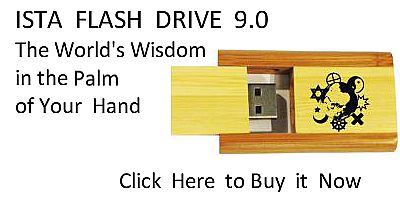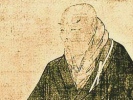
Sacred Texts Buddhism Index Previous Next
Buy this Book at Amazon.com


Shinran and His Work, by Arthur Lloyd, [1910], at sacred-texts.com
§§ 28, 29, 30.
The Shinshu has as its principal object of Veneration the Tathāgata Amitābha, "that is to say Namu-Amida-Butsu." * In the house-hold shrines of the laity there is no other object of worship but this: in temples and places of public worship, worship is offered also to Shinran Shōnin (now officially known as Kenshin-Daishi), to the zenchishiki "righteous and holy men," (a term which includes the founders and patron saints of the various honzan, or cathedrals of the sub-sects or dioceses mentioned in a previous chapter), to the Seven Kō-Sō, or Patriarchs honoured by Shinran in the Shōshinge, as responsible for the transmission of doctrine, and finally to Shōtoku Taishi, as the introducer of Buddhism into Japan, and as a great favourer of the Nembutsu practices and faith. These, together with Amida, form what are called the Go-hon-zama, or five classes of venerable Beings.
It is never, however, maintained that the worship given to Shinran, to the "righteous and holy men,"
to the Patriarchs, or to Shōtoku Taishi, stands on a par with that offered to Amida Himself. This may be seen by the fact that, in household worship, no notice is taken of any one of them, also that Mr. Nishimoto, in his Catechism, having just mentioned their names, never reverts to them again, and never attempts to build any doctrines on the worship offered to them. They are clearly of no doctrinal importance whatever, and the worship (matsuri) offered to them is clearly of that lower type which Christian theologians sometimes call latreia, to distinguish it from the perfected and whole-hearted douleia (or "slavery") which is due to God alone. Plato made the same distinction, so do the Hindoos. A Vaishnavite in India is practically a monotheist. He believes in One God with all his heart. Yet he will give a lesser worship to twenty minor deities, without feeling that he thereby takes aught from the worship due to Vishnu the Preserver. In the Shinshu, this lesser worship, or latreia, is reduced to very small limits, and may indeed be said to be almost non-existent. The Shinshu believer can no more be said to worship e.g. Shōtoku Taishi, in the ordinary sense of the term, than the Anglican can be said to worship St. Paul or St. John, because of the few Saint's Days in his Calendar.
But, however small may be the worship given by the Shinshu Buddhist to the unnamed Zenchishiki, or the somewhat obscure Patriarchs, of whom the average lay believer scarce knows the names, it is more than that which is given, either in households or Temples, to S’akyamuni himself. The Founder of Buddhism has absolutely no place
in the worship of this influential and powerful body of religious persons, who nevertheless call themselves Buddhists. I won't say that he has been wholly excluded from the Life of the Sect. His teachings are still much revered and studied, the Shinshu preacher still draws from the Sūtras the inspiration of his sermons, and Shinshu scholars have done as much as most for the elucidation of S’akyamuni's teachings. S’akyamuni is the Moses of Buddhism, but he has been extruded from the Shinshu Sanctuary; and we can well understand the indignation of Shinran's great opponent, Nichiren, when he found some children playing in the road with a broken image of S’akyamuni, which had been discarded from the Temple, as useless lumber, since the villagers had given ear to the exhortations of Shinran's itinerant preachers. * It is as hard to imagine a "Buddhism without Buddha," as it is to recognize a "Christianity without Christ."
Naturally, the Shinshu theologian has arguments to advance in defence of his position. It is said by some that, as the greater includes the less, so Amida includes S’akyamuni, the latter being only a partial manifestation or incarnation of the former. (This is the view known as ni son it-chi # "two Blessed Ones with One Object," as though the unity of purpose had resulted in the Unity of Person).
The other view is known as ni son bettai (#) "'two Blessed Ones with separate personalities." Those who hold this view maintain that S’akyamuni
was a distinct personage from Amida, and that he was and remains the Lord of the World that now .whereas Amida is Lord of the World to come. Shinshu is altogether a religion of the other world. It teaches men to put their whole trust in the Paradise prepared for them after death. It has therefore no need to teach fasting, celibacy, or the other religious practices which S’akyamuni was at such great pains to teach and institute.
Still, it must be confessed that the reasons thus given, though they would have been, perhaps, sound enough in the beginnings of Buddhism, as grounds for the total exclusion of S’akyamuni from the worship of the Buddhist communities, must have appeared in a very different light, when they were urged as grounds for the exclusion of S’akyamuni from the altars on which he had been venerated for fifteen centuries. A more radical revolution in religion can hardly be imagined.
Scarcely less strange is the absence, from nearly all the most modern authorities on Shinshu doctrine of all mention of the supposed Jōdo and Shinshu doctrine of the Trinity. Neither the Shinshu Hyakuwa, nor the Shinshu Seikun, as far as I have read it, nor Mr. Tada's works, as far as I am acquainted with them, allude to it. And yet in a Life of Shinran, published apparently as late as 1904 there is abundant evidence of it. In vol. i of that book, Amida is constantly spoken of as ikkō sanzon no Butsu (#) "the Buddha of three Persons and One Light," or as san son itchi (#) "the three Blessed Ones with one object." In this Trinity, Amitābha,
the Unoriginated, the Supreme, is the Father: by Him stands the Son, the Embodiment of Amitābha's Compassion,—in Sanskrit Avalokites’vara, "the Lord that looks down," in Japanese Kwanzeon, or Kwannon; and another, the Embodiment of his Wisdom,—in Sanskrit Mahāsthāmaprāpta, "He that hath obtained great strength," in Japanese, Seishi. *
The three are One, and the Father, Amida, is the Centre and the Heart of the Trinity, the source of Compassion and Wisdom. When the Compassion of the Most High is to be manifested to men, Kwannon, the Embodiment of the Compassion which is in the Godhead, becomes Incarnate: when the Wisdom of the Father, or his Might, is set forth, Seishi, the Embodiment of Divine Wisdom, manifests himself in and through some human personality.
So far the picture corresponds to our own ideas of the Trinity of God. But as the Gnostics of the Apostolic times, and especially those who sprang from the same regions and came into existence about the same time as the Buddhist Mahāyāna, held that the Divine Son had often become incarnate, (one of those incarnations being that one which took place at Bethlehem in the days of Herod), and as both Manes and Mahomet claimed to be the Paraclete, the Incarnation of God's Wisdom, so the Shinshu (and not the Shinshu alone) has believed in many incarnations and manifestations of Kwannon and,
[paragraph continues] Seishi, respectively the second and third persons of the Buddhist Trinity. It comes to one as a shock, after having been told that the Shinshu are the Unitarians of Buddhism, to learn, on the authority of a popular book, written for the edification of ignorant but pious persons, that Shōtoku Taishi was an Incarnation of Kwannon, that Hōnen Shōnin, the teacher of Shinran, was Seishi in the flesh, that Tamahi-no-miya, Shinran's wife, was an incarnation of Kwannon, and that Amida himself condescended to take flesh as Shinran. * The tendency of the present-day Shinshu is to drop these fabled incarnations, and we can only rejoice that it should be so. We lose our reverence for an Incarnate God when Iris Incarnations are constantly taking place in varied forms and shapes. But it is interesting to find ourselves thus brought face to face, once more, with one of the earliest problems of Christian History, and to be under the necessity, as Christians, of proving once more that there has been but one Incarnation of the Godhead—that of God in Christ. It is a significant point in our favour that the official Shinshu teaching also recognizes but one Incarnation properly so called,—that of Amida in Hōzo Biku. Our Catechism of the Shinshu mentions no other. The rest are apparitions rather than Incarnations. †
57:* I believe that a distinction is sometimes made between Amida Nyorai, and Namu-amide-Butsu. The former is used to denote Him, as he was and ever will be, the Absolute. The latter term (which is also the invocation of praise) is Amida, after his Incarnation as Hōzō Biku, when he had attained his glory and received the "Name above every Name."
59:* This incident was one of `the turning points in Nichiren's life.
61:* I often think in connection with this grouping of Buddhistic deities, of Zechariah's Vision of the two witnesses the priestly and the royal—that stood before the Lord of the whole earth.
62:* Shinran Shōnin Go ichidai Kōwa vol. i, p. 71, 73.
62:† The Shinshuist gets his teaching of the incarnations of Kwannon from the Fumonbon, a chapter of the Hokkekyō. But the Hokkekyō is not officially recognized as one of the fundamental documents of the Shinshu. It is indeed the strongest weapon the Nichiren sect possesses for combating what it considers to be the Shinshu heresies concerning Buddha.
SIGN UP!!! CLICK HERE TO GET 52 BOOKS FREE!!

SIGN UP!! FOR BOOKS AND REGULAR ARTICLES
https://againstsatanism.com/Prices.htm
HOW TO DEFEAT SATANISM AND LUCIFERIANISM AND BOOST YOUR EVOLUTION THROUGH ENERGY ENHANCEMENT MEDITATION "I have experience of many forms of meditation and practices for self improvement including: Transcendental meditation (TM) 12 years, Kriya Yoga 9 years, Sushila Buddhi Dharma (SUBUD) 7 years, and more recently the Sedona Method and the Course in Miracles.
The Energy Enhancement programme encapsulates and expands all of these systems, it is complete and no questions are left unanswered."
Energy Enhancement Level 0 Super Chi Prana, Power, Strength, Immortality
https://www.energyenhancement.org/LEVEL-Energy-Enhancement-Super-Chi-Immortality-Prana-Meditation-Course.htm
Energy
Enhancement Meditation LEVEL 1 Immortality - Activate the Antahkarana! Gain
Infinite Energy from the Chakras above the Head - Power UP!! Open Your Third
Eye, Gain Super Samadhi Kundalini Alchemical VITRIOL Energy. Ground All Negative
Energies. Access Quantum Immortality
Energy
Enhancement Meditation LEVEL 2 - The Energy Enhancement Seven Step Process to Totally
Remove Energy Blockages, Totally Remove All
Problems, Totally Remove Negative Emotions, Heal Your DNA, Remove your Karma -
OPEN YOUR LIFE!!
Energy
Enhancement Meditation LEVEL 3 - Eliminate even Deeper Energy Blockages - The
Removal of Strategies. Quantum Integration. The Karma Cleaning Process to
Totally Eliminate All Your Karma, all your Trauma, all your Energy Blockages
from All your Past Lifetimes!!
https://www.energyenhancement.org/Level3.htm
Energy
Enhancement Meditation LEVEL 4 - Stop the Suck!! Heal All your Relationships!! Find Your
Twin Flame!! MASTER ENERGY CONNECTIONS AND
RELATIONSHIPS
OUR SPECIAL MEDITATION REVOLUTION OFFER!!
WE HAVE THE TECHNOLOGY
WE CAN REMOVE YOUR ENERGY BLOCKAGES, ENTITIES AND DEMONS
WE CAN RE-BUILD YOU..